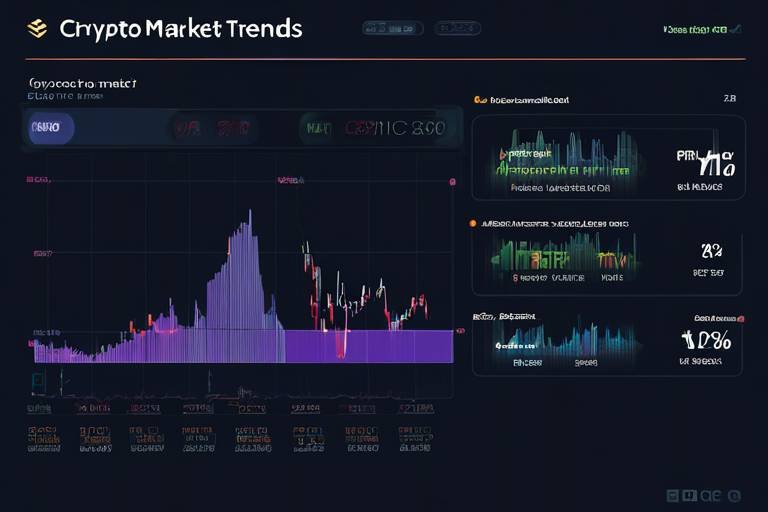Tips for Trading in a Bear Market
Trading in a bear market can feel like navigating a stormy sea. The winds are against you, and the waves of uncertainty can be intimidating. But fear not! With the right strategies and mindset, you can turn these turbulent times into opportunities. This article provides essential strategies and insights for navigating the challenges of trading during a bear market, helping investors make informed decisions and potentially capitalize on market downturns.
A bear market is characterized by a significant decline in stock prices, typically defined as a drop of 20% or more from recent highs. Recognizing its features can help traders prepare and adjust their strategies accordingly to mitigate risks and seize opportunities. The emotional rollercoaster of a bear market can lead to panic selling, but understanding market trends and historical patterns can empower you to make rational decisions. Think of it as a game of chess; every move counts, and anticipation is key.
Effective risk management is crucial in a bear market. Implementing stop-loss orders and diversifying your portfolio can help protect investments and limit potential losses during periods of market volatility. Remember, it's not just about what you buy, but how you protect what you own. By being proactive rather than reactive, you can weather the storm more effectively.
Stop-loss orders can automatically sell your securities when they reach a certain price, helping to minimize losses. Understanding how to set these orders effectively is vital for bear market trading. Think of stop-loss orders as your safety net; they catch you before you fall too far. When setting these orders, consider your overall investment strategy and market conditions. It's essential to strike a balance between protecting your assets and allowing for normal market fluctuations.
Identifying the appropriate price point for stop-loss orders requires market analysis and personal risk tolerance. This decision can significantly impact your overall trading strategy and loss mitigation. Take the time to analyze historical price movements and set your stop-loss orders at levels that align with your investment goals. Remember, every trader has a different risk appetite, so tailor your approach to suit your comfort level.
As market conditions change, adjusting stop-loss levels becomes necessary. Regularly reviewing and modifying these orders can help protect profits and minimize losses in a fluctuating bear market. Just like a ship adjusts its sails to navigate changing winds, you too must be flexible in your approach. Stay informed about market trends and be ready to adapt your strategies as needed.
Diversifying your investments across different asset classes can reduce risk exposure. In a bear market, focusing on defensive stocks or alternative investments can help stabilize your portfolio. Think of diversification as a balanced diet; just as eating a variety of foods keeps you healthy, a well-diversified portfolio can help safeguard your investments. Consider allocating funds to bonds, real estate, or even commodities during turbulent times.
Defensive stocks tend to perform better during economic downturns. Recognizing these stocks can provide a safer investment avenue while navigating the challenges of a bear market. Companies in sectors like utilities, healthcare, and consumer staples often remain stable, as people need these services regardless of economic conditions. Investing in these stocks can be like having an umbrella on a rainy day; it won’t stop the rain, but it will keep you dry.
Defensive stocks typically belong to industries that remain stable during economic declines, such as utilities and consumer staples. Understanding their characteristics can aid in selecting resilient investments. Look for companies with strong balance sheets, consistent earnings, and a history of paying dividends. These traits can be indicators of a stock’s ability to weather economic storms.
Dividend-paying stocks can offer a steady income stream during bear markets. Evaluating their financial health and payout ratios is essential to ensure sustainability and minimize risks. Companies that can maintain or grow their dividends during tough times are often more resilient. It’s like having a reliable friend who supports you when times get tough; these stocks can provide a cushion when the market gets rocky.
Short selling allows traders to profit from declining stock prices. Understanding the mechanics and risks involved can help investors make informed decisions during bear market conditions. While short selling can be a powerful tool, it’s essential to approach it with caution. It’s not just about betting against the market; it requires a deep understanding of market trends and potential pitfalls.
While short selling can be profitable, it carries significant risks, including unlimited losses. Traders must carefully assess their risk tolerance and market conditions before engaging in this strategy. Unlike traditional investing, where your losses are capped at your initial investment, short selling can lead to losses that exceed your initial stake. This makes it crucial to have a solid risk management plan in place.
Successfully timing short sales is crucial for profitability. Analyzing market trends and indicators can help traders identify optimal entry and exit points for their short positions. It’s like catching a wave; you want to ride it at just the right moment for maximum benefit. Keep an eye on market sentiment, technical indicators, and news that could impact stock prices to improve your timing.
- What is a bear market? A bear market is defined as a decline of 20% or more in stock prices from recent highs.
- How can I protect my investments during a bear market? Implementing stop-loss orders and diversifying your portfolio are effective strategies to mitigate risks.
- What are defensive stocks? Defensive stocks are shares in companies that tend to remain stable during economic downturns, often found in sectors like utilities and consumer goods.
- Is short selling a good strategy in a bear market? Short selling can be profitable in a bear market, but it carries significant risks and requires careful analysis.

Understanding Bear Markets
A bear market is more than just a dip in stock prices; it’s a significant downturn that can shake even the most seasoned investors. Typically defined as a decline of 20% or more in a broad market index, bear markets can be triggered by various factors, including economic downturns, geopolitical tensions, or even shifts in investor sentiment. Understanding the dynamics of a bear market is crucial for anyone looking to navigate through these turbulent waters.
During a bear market, fear often reigns supreme, leading to a massive sell-off as investors rush to cut their losses. This creates a self-perpetuating cycle where falling prices trigger more selling, further driving down the market. It's essential to recognize some of the key characteristics of bear markets:
- Prolonged Decline: Unlike a correction, which might last a few weeks, bear markets can persist for months or even years.
- Investor Sentiment: The mood among investors is typically pessimistic, with a prevailing belief that prices will continue to fall.
- High Volatility: Prices can fluctuate wildly, leading to uncertainty and increased risk for traders.
Recognizing these signs can help traders prepare and adjust their strategies accordingly. For instance, you might consider shifting your focus to more defensive investments that can weather the storm. It's like being in a boat during a storm; instead of trying to ride the waves, you want to anchor down and stay steady until the waters calm.
Moreover, understanding the economic indicators that often precede a bear market can provide valuable insights. Indicators such as rising unemployment rates, decreasing consumer confidence, and declining GDP growth can signal trouble ahead. Keeping an eye on these metrics can help you make informed decisions about when to enter or exit positions.
In conclusion, while bear markets can be daunting, they also present unique opportunities for those willing to adapt. By understanding the characteristics and indicators of bear markets, you can position yourself to not just survive but potentially thrive in challenging times.
- What causes a bear market? Bear markets can be caused by various factors, including economic downturns, high inflation, and geopolitical instability.
- How long do bear markets typically last? While there is no set duration, bear markets can last from a few months to several years, depending on the underlying economic conditions.
- Can I profit during a bear market? Yes, strategies such as short selling and investing in defensive stocks can help you profit during bear markets.

Risk Management Strategies
When it comes to trading in a bear market, effective risk management is not just a strategy; it's a necessity. Think of it as your safety net when the market takes a nosedive. The key is to be proactive rather than reactive. By anticipating potential losses and having a plan in place, you can navigate the stormy seas of a bear market with greater confidence. One of the most effective ways to manage risk is through the use of stop-loss orders and by diversifying your portfolio.
Stop-loss orders are like your personal bodyguard in the trading world. They automatically sell your securities when they hit a predetermined price, helping you to cut losses before they spiral out of control. Imagine you're holding a stock that starts to plummet; a stop-loss order can be your lifesaver, ensuring you don’t lose more than you can afford. However, setting these orders isn't as simple as it sounds. You need to determine the right price point based on market analysis and your personal risk tolerance. This decision can significantly impact your overall trading strategy.
When setting stop-loss orders, it's crucial to consider the current market conditions and your investment goals. For instance, if you're trading a highly volatile stock, you might want to set a wider stop-loss to avoid being triggered by short-term fluctuations. Conversely, for more stable stocks, a tighter stop-loss might be appropriate. Regularly reviewing and adjusting these levels as market conditions change can help you protect your profits and minimize losses effectively.
Identifying the appropriate price point for your stop-loss orders requires a blend of market analysis and self-awareness regarding your risk appetite. A common approach is to set your stop-loss at a percentage below the current price—often between 5% to 15%. However, this isn't a one-size-fits-all solution. What works for one trader may not work for another, as it heavily depends on the stock's volatility and your trading style. The goal is to find a balance where you can protect your investments without getting stopped out prematurely.
As the market landscape shifts, so too should your stop-loss levels. For instance, if a stock you own begins to rise significantly, you might want to adjust your stop-loss order upwards to lock in profits. This practice, known as a trailing stop-loss, can help you ride the upward momentum while still offering protection against sudden downturns. Regularly monitoring and modifying these orders is essential, especially in a bear market where volatility can be rampant.
Another critical aspect of risk management is diversification. By spreading your investments across various asset classes, you can reduce your overall risk exposure. In a bear market, this means focusing on defensive stocks or alternative investments that can help stabilize your portfolio. For example, consider allocating a portion of your investments to sectors like utilities or consumer staples, which tend to be more resilient during economic downturns.
Diversification isn't just about having a mix of stocks; it's about strategically choosing assets that can perform differently under various market conditions. You might want to look into bonds, commodities, or even real estate as part of your investment strategy. By doing so, you're not putting all your eggs in one basket, which is especially critical during a bear market when certain sectors may falter while others thrive.
In summary, navigating a bear market requires a robust risk management strategy that includes setting stop-loss orders and diversifying your portfolio. By being proactive and adaptable, you can mitigate risks and potentially capitalize on market downturns. Remember, the goal is to protect your investments while positioning yourself for future opportunities.
- What is a bear market? A bear market is typically defined as a period when stock prices fall by 20% or more from recent highs, often accompanied by widespread pessimism.
- How can I protect my investments during a bear market? Implementing stop-loss orders, diversifying your portfolio, and focusing on defensive stocks can help protect your investments.
- Is short selling a good strategy in a bear market? Short selling can be profitable but carries significant risks. It's crucial to assess your risk tolerance and market conditions before engaging in this strategy.

Setting Stop-Loss Orders
When navigating the tumultuous waters of a bear market, one of the most effective tools at your disposal is the stop-loss order. Think of it as a safety net that catches you before you fall too far. A stop-loss order is an instruction you give to your broker to sell a security when it reaches a certain price. This can be a game-changer, especially when the market is in freefall. By setting these orders, you can protect your investments from significant losses, allowing you to sleep a little easier at night knowing there's a plan in place.
Understanding how to set stop-loss orders effectively is crucial. The key is to determine the right price point at which to trigger the sale. This isn't just a random number; it requires some serious thought and analysis. Factors to consider include your risk tolerance, the volatility of the stock, and overall market conditions. For instance, if you're trading a stock that's known for its wild price swings, you might want to set a wider stop-loss to avoid being triggered by normal fluctuations.
To help you visualize the process, consider the following table that outlines the steps to set a stop-loss order:
| Step | Description |
|---|---|
| 1 | Assess your risk tolerance and determine how much loss you can accept. |
| 2 | Analyze the stock's price history to identify key support levels. |
| 3 | Set your stop-loss order slightly below a support level to minimize the chance of being triggered by normal volatility. |
| 4 | Regularly review and adjust your stop-loss orders as market conditions change. |
Another important aspect to consider is the adjustment of stop-loss levels. As the market shifts, so should your strategy. If a stock starts to gain traction and your investment is in the green, consider moving your stop-loss order up to lock in profits. This way, you’re not just protecting against losses but also ensuring that gains don’t slip away. By regularly reviewing your stop-loss orders, you can stay agile and responsive to market changes, which is essential in a bear market.
In summary, setting stop-loss orders isn't just about placing a safety net; it's about creating a proactive strategy that allows you to navigate the bear market with confidence. By understanding your risk tolerance, analyzing market conditions, and adjusting your orders as needed, you can significantly mitigate potential losses and position yourself for future gains.
- What is a stop-loss order? A stop-loss order is an instruction to sell a security when it reaches a specified price, helping to limit potential losses.
- How do I determine the right price point for a stop-loss order? Consider your risk tolerance, the stock's volatility, and key support levels in the market.
- Can I adjust my stop-loss order? Yes, you can and should adjust your stop-loss orders as market conditions change or as your investment position evolves.
- Are there different types of stop-loss orders? Yes, there are various types, including standard stop-loss orders and trailing stop-loss orders, which adjust automatically as the stock price moves.

Determining the Right Price Point
When it comes to for your stop-loss orders in a bear market, it’s like trying to find the sweet spot in a game of darts. You want to hit the bullseye but without overshooting or undershooting your target. The key lies in a mix of market analysis and understanding your own risk tolerance. First, you need to assess the current market conditions. Are stocks in a free fall, or are they merely experiencing a temporary dip? By analyzing market trends, you can better gauge where to set your stop-loss orders.
Next, consider your investment goals. Are you in it for the long haul, or are you looking to make a quick profit? This distinction is crucial. For instance, if you’re a long-term investor, you might be willing to set your stop-loss orders a bit further away from the current price, allowing for some fluctuations. On the other hand, if you’re a short-term trader, tighter stop-loss orders could help you minimize losses quickly.
Another important factor is to look at historical price levels. Analyzing past performance can reveal support and resistance levels that might serve as good indicators for setting your stop-loss. You can also use technical indicators like moving averages or Bollinger Bands to assist in your decision-making process. For example, setting your stop-loss just below a significant moving average might provide a safety net against further declines.
Here’s a quick breakdown of factors to consider when determining your stop-loss price point:
- Market Conditions: Is the market overall bearish or just volatile?
- Investment Goals: Are you a long-term holder or a short-term trader?
- Historical Data: What do past price movements tell you?
- Technical Indicators: Are there specific indicators you can rely on?
Ultimately, the right price point will vary from one investor to another, based on individual circumstances and market conditions. It’s essential to regularly review your stop-loss levels and adjust them as needed. Just like you wouldn’t wear the same clothes in winter and summer, your trading strategy should evolve with the changing market landscape. Stay flexible, stay informed, and you’ll be better equipped to navigate the choppy waters of a bear market.
Q1: What is a stop-loss order?
A stop-loss order is a tool used by traders to automatically sell a security when it reaches a specific price, helping to limit potential losses.
Q2: How do I determine my risk tolerance?
Your risk tolerance is influenced by your financial situation, investment goals, and emotional capacity to handle market fluctuations. Assessing these factors can help you determine how much risk you're willing to take.
Q3: Can I adjust my stop-loss orders?
Yes, you can and should adjust your stop-loss orders as market conditions change. Regularly reviewing your strategy is key to protecting your investments.
Q4: What are defensive stocks?
Defensive stocks are shares in companies that tend to remain stable during economic downturns, such as those in utilities and consumer staples.

Adjusting Stop-Loss Levels
In the ever-changing landscape of a bear market, is not just a good idea; it’s a necessity. Think of your stop-loss order as a safety net. If the market takes a nosedive, it can help prevent your portfolio from plummeting along with it. However, setting it and forgetting it is a recipe for disaster. Just like a pilot constantly checks the instruments, you need to regularly review and adjust your stop-loss levels based on market conditions.
First off, it’s crucial to understand that market conditions are not static. They shift due to a variety of factors—economic indicators, geopolitical events, or even social media trends can all influence stock prices. Therefore, what may have been a suitable stop-loss level yesterday might not hold up today. By staying informed and vigilant, you can make timely adjustments that protect your investments.
When adjusting stop-loss levels, consider the following key factors:
- Market Volatility: During times of high volatility, it may be wise to widen your stop-loss levels to avoid being stopped out on minor fluctuations.
- Stock Performance: If a stock is consistently performing well despite market downturns, you might want to tighten your stop-loss to lock in profits.
- Technical Indicators: Use technical analysis tools like moving averages or support levels to inform your adjustments. These indicators can signal when it might be prudent to raise or lower your stop-loss.
Another important aspect to consider is your risk tolerance. If you find that the current market conditions are causing you undue stress, it might be a good time to reassess your stop-loss strategy. After all, trading should not feel like walking a tightrope without a safety harness. By adjusting your stop-loss levels to align with your comfort zone, you can trade with confidence rather than fear.
Lastly, keep in mind that adjusting stop-loss levels isn’t a one-time event. It requires ongoing attention and a willingness to adapt. Just as a gardener prunes plants to encourage healthy growth, you must be ready to prune your stop-loss orders to foster a more resilient trading strategy. So, the next time you find yourself in a bear market, remember: your stop-loss levels are your allies in the battle against market downturns. Treat them with the care and attention they deserve!
If you’re still feeling a bit uncertain about stop-loss levels and their adjustments, don’t worry! Here are some frequently asked questions that might help clarify things:
- What is a stop-loss order? A stop-loss order is an automatic order to sell a security when it reaches a certain price, designed to limit an investor's loss.
- How often should I adjust my stop-loss levels? It’s advisable to review your stop-loss levels regularly, especially in a volatile market. Daily or weekly checks can help you stay aligned with market conditions.
- Can I set multiple stop-loss orders for the same stock? Yes, you can set multiple stop-loss orders, but be cautious. Each order should have a clear purpose and strategy behind it.

Diversification Techniques
Diversification is not just a fancy investment term; it's a lifeline in the turbulent waters of a bear market. Think of it as spreading your bets across different horses in a race. By not putting all your eggs in one basket, you can cushion the impact of a downturn on your overall portfolio. In a bear market, where stock prices are tumbling, having a diversified portfolio can provide a safety net that helps stabilize your financial health.
One effective way to diversify is by investing in different asset classes. This means mixing things up with stocks, bonds, real estate, and even commodities. For instance, while tech stocks might be plummeting, bonds could be performing well, acting as a buffer against losses. It's like having a balanced diet; a variety of investments can help you weather the storm when one sector faces challenges.
Moreover, within your stock investments, consider allocating funds to different sectors. Defensive sectors like utilities and healthcare tend to be more resilient during economic downturns. These sectors often provide essential services that consumers continue to use, regardless of the economic climate. On the other hand, consumer discretionary sectors, which include luxury goods and services, may take a hit as people tighten their belts. By understanding these dynamics, you can make informed decisions about where to allocate your resources.
Another technique to enhance your diversification strategy is to look into geographical diversification. Investing in international markets can further spread your risk. If the U.S. market is struggling, perhaps markets in Asia or Europe are thriving. This global perspective can open up new opportunities that might not be available in your home market.
Lastly, consider alternative investments such as real estate investment trusts (REITs) or commodities like gold. Historically, gold has been viewed as a safe haven during market downturns. By incorporating these assets into your portfolio, you can protect yourself against inflation and currency fluctuations, which often accompany bear markets.
In summary, diversification techniques are essential for navigating bear markets. By spreading your investments across various asset classes, sectors, and geographical regions, you can mitigate risks and potentially enhance your returns. Remember, just like in life, variety is the spice that can keep your investment journey exciting and less risky.
- What is the best way to diversify my portfolio during a bear market?
Consider investing in a mix of asset classes, sectors, and geographies. Defensive stocks, bonds, and alternative investments can provide stability. - How often should I review my diversification strategy?
Regularly review your portfolio, especially during volatile market conditions, to ensure your investments align with your risk tolerance and market changes. - Can diversification guarantee profits?
No, while diversification can reduce risk, it cannot guarantee profits. It's essential to stay informed and adapt your strategy as market conditions change.

Identifying Defensive Stocks
When the market takes a nosedive, investors often scramble for safety, and that's where defensive stocks come into play. These stocks are like the sturdy lifeboats in a stormy sea—they're designed to weather the economic downturns better than most. But how do you identify these resilient investments? It’s about looking for companies that belong to sectors that remain stable even when the economy is struggling. Think of industries like utilities, healthcare, and consumer staples. These companies provide essential goods and services that people need regardless of economic conditions.
Defensive stocks typically exhibit certain characteristics that make them less volatile than their cyclical counterparts. For instance, they often have strong balance sheets, consistent earnings, and a history of paying dividends. This financial stability can provide a sense of security during turbulent times. When evaluating potential defensive stocks, consider the following:
- Industry Stability: Look for companies in industries that are less affected by economic cycles.
- Dividend History: Companies that consistently pay dividends tend to be more stable.
- Low Volatility: Defensive stocks usually show less price fluctuation compared to the broader market.
To illustrate, let’s take a look at a comparison of defensive stocks versus cyclical stocks in a table format:
| Type of Stock | Example Industries | Performance During Bear Markets |
|---|---|---|
| Defensive Stocks | Utilities, Consumer Staples, Healthcare | Generally stable or slightly declining |
| Cyclical Stocks | Automotive, Travel, Luxury Goods | Significantly declining |
Investing in defensive stocks can be a strategic move during bear markets, as they often provide a cushion against significant losses. However, it’s essential to conduct thorough research and consider the company's fundamentals, market position, and potential for growth. While these stocks may not provide explosive returns, they can offer a reliable foundation for your portfolio when the market is shaky.
Q: What are defensive stocks?
A: Defensive stocks are shares from companies that tend to remain stable or perform well during economic downturns. They typically belong to industries that provide essential goods and services.
Q: How can I identify defensive stocks?
A: Look for companies in stable industries like utilities, healthcare, and consumer staples. Check their dividend history, financial health, and volatility compared to the broader market.
Q: Are defensive stocks a good investment during a bear market?
A: Yes, defensive stocks can be a safer investment during bear markets as they tend to be less affected by economic downturns, providing a level of stability to your portfolio.

Characteristics of Defensive Stocks
When navigating the turbulent waters of a bear market, defensive stocks emerge as a beacon of stability. These stocks belong to companies that provide essential goods and services, which means their demand remains relatively constant, even when the economy takes a nosedive. Think of them as the sturdy lifeboats in a stormy sea, keeping you afloat when the market waves are crashing around you. But what exactly sets these stocks apart from the rest? Let's dive deeper.
One of the primary characteristics of defensive stocks is their low volatility. Unlike growth stocks that can soar to impressive heights during bull markets, defensive stocks tend to have a more stable price trajectory. This stability is primarily due to the nature of the industries they operate in. Companies in sectors such as utilities, healthcare, and consumer staples provide products and services that people need regardless of economic conditions. For instance, think about how you continue to pay your electricity bill or buy groceries even when times are tough. This consistent demand helps cushion defensive stocks from the full brunt of market downturns.
Another defining feature of defensive stocks is their ability to generate steady cash flows. These companies often have established business models with reliable revenue streams. This consistent performance allows them to maintain their dividend payouts, making them attractive to income-seeking investors. In fact, many defensive stocks are known for their dividend resilience, meaning they are less likely to cut dividends during economic downturns. This characteristic can provide a much-needed cushion for investors looking to weather the storm.
Moreover, defensive stocks often have strong balance sheets, which means they possess a healthy mix of assets and manageable debt levels. This financial strength allows them to endure economic challenges better than their more speculative counterparts. In a bear market, having investments in companies with robust financial health can significantly reduce your overall portfolio risk.
To sum it up, the characteristics of defensive stocks can be summarized as follows:
- Low Volatility: Prices remain stable during market fluctuations.
- Steady Cash Flows: Reliable revenue generation leads to consistent dividends.
- Strong Balance Sheets: Financial strength and lower debt levels enhance resilience.
By focusing on these characteristics, investors can identify defensive stocks that not only provide safety during market downturns but also offer potential for long-term growth when the economic tide turns in their favor. So, if you're looking to fortify your portfolio against the unpredictable nature of bear markets, consider incorporating these stalwarts into your investment strategy. After all, a well-rounded portfolio is like a well-armed ship; it can weather any storm!
Q: What are defensive stocks?
A: Defensive stocks are shares in companies that provide essential goods and services, which tend to maintain stable demand even during economic downturns. They are generally found in sectors like utilities, healthcare, and consumer staples.
Q: Why are defensive stocks considered safe investments?
A: Defensive stocks are considered safe because they exhibit low volatility, generate steady cash flows, and often have strong balance sheets. This makes them less susceptible to market fluctuations compared to growth stocks.
Q: Can defensive stocks provide dividends?
A: Yes, many defensive stocks are known for their ability to maintain or increase dividend payouts, even during tough economic times, making them attractive to income-focused investors.
Q: How can I identify defensive stocks?
A: Look for companies in essential industries, assess their financial health, and check their historical performance during economic downturns. You can also consider their dividend history as an indicator of stability.

Evaluating Dividend Stocks
When it comes to investing during a bear market, dividend stocks can be a beacon of hope. These stocks not only provide a potential for capital appreciation but also offer a steady stream of income, which can be a lifesaver when the market is in turmoil. However, not all dividend stocks are created equal, and evaluating them properly is crucial to ensuring that your investments are sustainable and resilient.
First and foremost, it's essential to look at the company's financial health. A company that consistently pays dividends typically has a strong balance sheet and robust cash flow. To assess this, you should examine key financial metrics such as:
- Dividend Payout Ratio: This ratio indicates what portion of a company's earnings is paid out as dividends. A lower payout ratio suggests that the company retains more earnings for growth, which is generally a positive sign.
- Debt-to-Equity Ratio: A high level of debt can jeopardize a company's ability to pay dividends, especially during economic downturns. Look for companies with manageable debt levels.
- Free Cash Flow: Positive free cash flow is crucial for sustaining dividend payments. It shows that a company has enough cash after expenses to distribute dividends to shareholders.
After scrutinizing financial health, consider the dividend yield. This metric shows how much a company pays in dividends relative to its stock price. A higher yield can seem attractive, but beware of yields that appear too good to be true. Sometimes, an unusually high yield may indicate underlying problems in the company, such as a plummeting stock price due to poor performance. Therefore, it’s vital to analyze the reasons behind the high yield.
Another factor to consider is the company's dividend history. A consistent track record of dividend payments, especially during economic downturns, can indicate stability and a commitment to returning value to shareholders. Look for companies that have not only maintained their dividends but have also increased them over time. This is often a sign of a company’s confidence in its future earnings.
Finally, don't forget to assess the company's industry position. Some industries are more resilient during bear markets than others. For example, utilities and consumer staples often fare better than cyclical sectors like technology or luxury goods. Understanding where a company stands within its industry can provide valuable insight into its ability to weather economic storms.
| Metric | Importance | What to Look For |
|---|---|---|
| Dividend Payout Ratio | Indicates sustainability of dividends | Lower ratio is generally better |
| Debt-to-Equity Ratio | Measures financial risk | Lower ratio suggests less risk |
| Free Cash Flow | Essential for paying dividends | Positive cash flow is crucial |
| Dividend History | Shows commitment to shareholders | Consistent or growing dividends preferred |
| Industry Position | Indicates stability during downturns | Defensive industries are safer |
In summary, evaluating dividend stocks requires a comprehensive approach that includes analyzing financial health, assessing dividend yield, reviewing dividend history, and understanding industry dynamics. By taking these factors into account, you can make more informed decisions that not only protect your investments but also potentially enhance your returns during challenging market conditions.
Q: What is a dividend stock?
A: A dividend stock is a share in a company that pays out a portion of its earnings to shareholders in the form of dividends. These stocks are often seen as a way to generate income.
Q: How do I know if a dividend stock is safe?
A: Look for companies with a strong financial position, a history of consistent dividend payments, and reasonable payout ratios. Avoid companies with high debt levels or erratic dividend histories.
Q: Can I rely solely on dividend stocks for income?
A: While dividend stocks can provide a steady income stream, it’s wise to diversify your investments across different asset classes to mitigate risk.
Q: What happens to dividends in a bear market?
A: In a bear market, some companies may cut or suspend their dividends due to decreased earnings. It's crucial to monitor your dividend stocks regularly during these periods.

Utilizing Short Selling
Short selling is a trading strategy that can be particularly effective during a bear market. Essentially, it allows traders to profit from the decline in stock prices by borrowing shares and selling them at the current market price, with the intention of buying them back later at a lower price. This strategy can be likened to a roller coaster ride; while it can be thrilling and profitable, it also comes with its fair share of risks that can lead to significant losses if not managed properly.
Before diving into short selling, it's crucial to understand the mechanics of how it works. When you short a stock, you're essentially betting that its price will fall. If you successfully predict the market's direction, you can buy back the shares at a lower price, return them to the lender, and pocket the difference. However, if the stock price rises instead of falls, you could face unlimited losses, as there's theoretically no cap on how high a stock's price can go. This aspect makes short selling a double-edged sword, and one must tread carefully.
To effectively utilize short selling in a bear market, timing is everything. Traders need to analyze market trends and indicators meticulously. For example, consider the following factors when deciding when to short a stock:
- Market Sentiment: Is the overall market feeling bearish? A pessimistic outlook can signal a good time to short.
- Technical Indicators: Look for patterns in stock price movements that suggest a downturn, such as head and shoulders formations or bearish divergence.
- Company News: Negative news about a company, such as poor earnings reports or management scandals, can lead to a decline in stock price, making it an ideal candidate for shorting.
Moreover, it's essential to set a clear exit strategy when engaging in short selling. This means determining your target price for buying back the shares and setting stop-loss orders to limit potential losses. Remember, just as you wouldn’t jump into a pool without checking the depth first, you shouldn't enter a short position without a solid plan in place.
To illustrate the potential outcomes of short selling, consider the following hypothetical scenario:
| Action | Price at Short Sale | Price at Buy Back | Profit/Loss |
|---|---|---|---|
| Short Sell | $100 | $80 | +$20 (Profit) |
| Short Sell | $100 | $120 | -$20 (Loss) |
In this table, you can see how the outcome of short selling can vary dramatically based on market movements. The key takeaway here is to stay informed, remain vigilant, and always be prepared for the unexpected. In a bear market, where volatility reigns supreme, having a flexible strategy and a keen eye on market trends can make all the difference between a successful trade and a costly mistake.
In conclusion, while short selling can be a powerful tool in a trader's arsenal, it requires a solid understanding of the risks involved and a strategic approach to execution. By carefully analyzing market conditions, setting clear goals, and having a robust risk management plan, traders can navigate the complexities of a bear market more effectively.
1. What is short selling?
Short selling is a trading strategy that involves borrowing shares of a stock and selling them with the expectation that the price will decline, allowing the trader to buy them back at a lower price.
2. What are the risks of short selling?
The primary risk of short selling is the potential for unlimited losses, as there is no cap on how high a stock's price can rise. Additionally, if the market moves against the trader's position, they may be forced to cover their short at a loss.
3. How can I identify good short selling opportunities?
Look for stocks with negative news, bearish market sentiment, and technical indicators that suggest a price decline. Analyzing these factors can help identify potential short selling opportunities.
4. Should I use stop-loss orders when short selling?
Yes, using stop-loss orders is crucial when short selling to limit potential losses. Setting a clear exit strategy can help protect your investment.

Understanding Short Selling Risks
This article provides essential strategies and insights for navigating the challenges of trading during a bear market, helping investors make informed decisions and potentially capitalize on market downturns.
A bear market is characterized by a significant decline in stock prices. Recognizing its features can help traders prepare and adjust their strategies accordingly to mitigate risks and seize opportunities.
Effective risk management is crucial in a bear market. Implementing stop-loss orders and diversifying your portfolio can help protect investments and limit potential losses during periods of market volatility.
Stop-loss orders can automatically sell your securities when they reach a certain price, helping to minimize losses. Understanding how to set these orders effectively is vital for bear market trading.
Identifying the appropriate price point for stop-loss orders requires market analysis and personal risk tolerance. This decision can significantly impact your overall trading strategy and loss mitigation.
As market conditions change, adjusting stop-loss levels becomes necessary. Regularly reviewing and modifying these orders can help protect profits and minimize losses in a fluctuating bear market.
Diversifying your investments across different asset classes can reduce risk exposure. In a bear market, focusing on defensive stocks or alternative investments can help stabilize your portfolio.
Defensive stocks tend to perform better during economic downturns. Recognizing these stocks can provide a safer investment avenue while navigating the challenges of a bear market.
Defensive stocks typically belong to industries that remain stable during economic declines, such as utilities and consumer staples. Understanding their characteristics can aid in selecting resilient investments.
Dividend-paying stocks can offer a steady income stream during bear markets. Evaluating their financial health and payout ratios is essential to ensure sustainability and minimize risks.
Short selling allows traders to profit from declining stock prices. Understanding the mechanics and risks involved can help investors make informed decisions during bear market conditions.
While short selling can be an enticing strategy to profit from falling stock prices, it is essential to recognize the inherent risks involved. One of the most significant risks is the potential for unlimited losses. Unlike traditional investing, where the maximum loss is capped at the amount invested, short selling can lead to losses that far exceed your initial investment. This is because there is no upper limit to how high a stock’s price can rise, meaning that if you short a stock and its price increases, you could be forced to buy back at a much higher price.
Additionally, short selling can lead to margin calls. When you short a stock, you typically borrow shares to sell them, which means you are using margin. If the stock price rises significantly, your broker may require you to deposit more money into your account to cover the losses, which can put additional strain on your finances.
Furthermore, the market can be unpredictable. Just because a stock is declining now doesn’t mean it will continue to do so. Market sentiment can change rapidly, influenced by news, earnings reports, or macroeconomic factors. Therefore, timing your short sales becomes crucial. The following table outlines some key risks associated with short selling:
| Risk Factor | Description |
|---|---|
| Unlimited Losses | Theoretically, there’s no limit to how high a stock price can rise, leading to potentially unlimited losses. |
| Margin Calls | Increased stock prices can trigger margin calls, requiring additional funds to maintain your position. |
| Market Volatility | Rapid changes in market sentiment can lead to unexpected price movements, affecting your short position. |
In summary, understanding these risks is vital before diving into the world of short selling. It’s not just about identifying a stock that you think will decline; it’s about ensuring that you are prepared for the potential consequences of that decision. Always assess your own risk tolerance and market conditions before engaging in this strategy.
- What is a bear market? A bear market is typically defined as a period in which stock prices fall by 20% or more from recent highs.
- How can I protect my investments during a bear market? Implementing risk management strategies such as stop-loss orders and diversifying your portfolio can help protect your investments.
- What are defensive stocks? Defensive stocks are shares in companies that tend to remain stable during economic downturns, often found in industries like utilities and consumer staples.
- Is short selling risky? Yes, short selling carries significant risks, including the potential for unlimited losses and margin calls.

Timing Your Short Sales
Successfully timing your short sales is crucial for profitability in a bear market. Think of it like catching a wave; if you paddle out at the right moment, you can ride it to shore, but if you miss the timing, you might just end up treading water. Analyzing market trends and indicators can help traders identify optimal entry and exit points for their short positions. This isn’t just about jumping in at any price; it’s about understanding the ebb and flow of the market and positioning yourself wisely.
To effectively time your short sales, you should consider several key factors:
- Market Sentiment: Gauge the overall mood of the market. Are investors feeling bearish? Look for signs of fear or panic, as these can often signal a good time to short.
- Technical Indicators: Utilize tools like moving averages, Relative Strength Index (RSI), and Bollinger Bands to identify overbought conditions that may precede a price drop.
- News and Events: Stay updated on economic reports, earnings announcements, and geopolitical events. These can drastically affect stock prices and provide opportunities for short selling.
Moreover, understanding the concept of short squeezes is essential. A short squeeze occurs when a heavily shorted stock's price rises unexpectedly, forcing short sellers to buy back shares to cover their positions, which can lead to even higher prices. This is like being caught in a rip current; if you’re not careful, you can be pulled under before you even realize what’s happening. Therefore, it’s crucial to set clear exit points and stick to them to avoid getting caught in a squeeze.
Another effective strategy is to monitor the volume of trading. High trading volumes can indicate increasing interest in a stock, which can precede a price drop. If you notice a stock that has been heavily shorted suddenly experiencing high volume, it might be time to jump in. Think of it as watching the tide come in; if the waves are crashing, it’s usually a sign that something significant is happening beneath the surface.
Lastly, always have a plan in place. This includes determining your risk tolerance and setting stop-loss orders to protect yourself from unexpected price movements. Just like a sailor wouldn’t set sail without a map, you shouldn’t enter a short position without a clear strategy. By carefully analyzing market trends, staying informed, and having a solid plan, you can increase your chances of successfully timing your short sales and potentially profiting even in a bear market.
Q: What is short selling?
A: Short selling is a trading strategy that involves borrowing shares of a stock and selling them with the intention of buying them back at a lower price. This allows traders to profit from declining stock prices.
Q: What are the risks associated with short selling?
A: The primary risk of short selling is that losses can be unlimited. If the stock price rises instead of falls, you’ll have to buy back the shares at a higher price, resulting in significant losses.
Q: How can I identify a good short selling opportunity?
A: Look for stocks that are overvalued, have poor fundamentals, or are experiencing negative news. Additionally, technical indicators like high RSI can signal a potential price drop.
Q: Is there a best time to short sell?
A: Timing can vary, but generally, short selling is more favorable when market sentiment is negative, during earnings reports, or when there are signs of market overextension.
Frequently Asked Questions
- What is a bear market?
A bear market is typically defined as a period when stock prices fall by 20% or more from their recent highs. It can be a challenging time for investors, but understanding its characteristics can help you navigate the downturn.
- How can I manage risks during a bear market?
Effective risk management is crucial in a bear market. You can implement strategies like setting stop-loss orders to automatically sell your stocks at a certain price, and diversifying your portfolio across different asset classes to minimize risk.
- What are stop-loss orders, and how do I set them?
Stop-loss orders are designed to limit your losses by automatically selling a security when it reaches a specified price. To set them effectively, analyze market conditions and determine a price point that aligns with your risk tolerance.
- What are defensive stocks, and why are they important?
Defensive stocks are shares of companies that tend to remain stable or perform well during economic downturns, such as utilities and consumer staples. Investing in these stocks can provide a safer haven during bear markets.
- How can I evaluate dividend stocks in a bear market?
When evaluating dividend stocks, consider their financial health, payout ratios, and historical performance. This can help you identify stocks that can provide a reliable income stream even when the market is down.
- What is short selling, and how does it work?
Short selling involves borrowing shares and selling them with the expectation that the stock price will decline. You can then buy back the shares at a lower price to return them, profiting from the difference. However, it carries significant risks, including the potential for unlimited losses.
- How do I know when to time my short sales?
Timing short sales requires careful analysis of market trends and indicators. Look for signs of declining prices and market sentiment to identify optimal entry and exit points for your short positions.



















